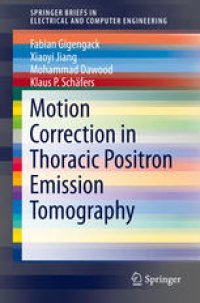
Ebook: Motion Correction in Thoracic Positron Emission Tomography
- Tags: Computer Imaging Vision Pattern Recognition and Graphics, Imaging / Radiology, Signal Image and Speech Processing
- Series: SpringerBriefs in Electrical and Computer Engineering
- Year: 2015
- Publisher: Springer International Publishing
- Edition: 1
- Language: English
- pdf
Respiratory and cardiac motion leads to image degradation in Positron Emission Tomography (PET), which impairs quantification. In this book, the authors present approaches to motion estimation and motion correction in thoracic PET. The approaches for motion estimation are based on dual gating and mass-preserving image registration (VAMPIRE) and mass-preserving optical flow (MPOF). With mass-preservation, image intensity modulations caused by highly non-rigid cardiac motion are accounted for. Within the image registration framework different data terms, different variants of regularization and parametric and non-parametric motion models are examined. Within the optical flow framework, different data terms and further non-quadratic penalization are also discussed. The approaches for motion correction particularly focus on pipelines in dual gated PET. A quantitative evaluation of the proposed approaches is performed on software phantom data with accompanied ground-truth motion information. Further, clinical applicability is shown on patient data. The book concludes with an outlook of recent developments and potential future advances in the field of PET motion correction.
Respiratory and cardiac motion leads to image degradation in Positron Emission Tomography (PET), which impairs quantification. In this book, the authors present approaches to motion estimation and motion correction in thoracic PET. The approaches for motion estimation are based on dual gating and mass-preserving image registration (VAMPIRE) and mass-preserving optical flow (MPOF). With mass-preservation, image intensity modulations caused by highly non-rigid cardiac motion are accounted for. Within the image registration framework different data terms, different variants of regularization and parametric and non-parametric motion models are examined. Within the optical flow framework, different data terms and further non-quadratic penalization are also discussed. The approaches for motion correction particularly focus on pipelines in dual gated PET. A quantitative evaluation of the proposed approaches is performed on software phantom data with accompanied ground-truth motion information. Further, clinical applicability is shown on patient data. The book concludes with an outlook of recent developments and potential future advances in the field of PET motion correction.